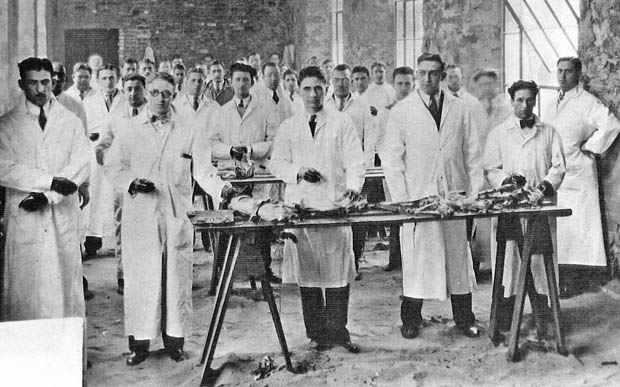Special exhibit examines campus' previous occupant
History of Middlesex University, battle for accreditation, honored
 Photos courtesy of Robert D. Farber University Archives & Special Collections
Photos courtesy of Robert D. Farber University Archives & Special CollectionsPre-med lab class at Middlesex University, 1930
The Robert D. Farber University Archives & Special Collections Department at Brandeis is paying homage to Middlesex in an exhibit entitled “Castles and Controversies: The Story of Middlesex University,” currently running in the Goldfarb Library. The exhibit features a history of Middlesex, information on the schools, documents relating to the accreditation controversy, medical artifacts from the 1940s, and photographs of campus, labs, classrooms and students.
On Wednesday, Sept. 12, from 4 to 6 p.m., alumni of Middlesex and their families will bring stories about their years in Waltham to accompany the exhibit. Everyone is welcome.
“While some alumni have a complex relationship with the institution" that formally occupied Usen Castle, "we have heard a great deal of enthusiasm about the exhibit,” says Sarah Shoemaker, director of university archives and special collections. “A number of alumni have contributed their artifacts.”
Part of the exhibit is devoted to the controversy of Middlesex not being accepted into the American Medical Association (AMA), the battle to be accepted by the AMA and the similar battles that the veterinary school endured with the American Veterinary Medical Association.
There have been discussions that perhaps some of the accreditation issues arose because theories and concepts at Middlesex were, at times, contrary to those of traditional schools. The 1929 course catalog, for example, states that Middlesex believed in eclectic medicine, meaning students were open to discuss and challenge some of the medical theories with their own ideas.
In addition, there were no quotas for admission ‑ people of color, women, Jews and Catholics were welcome.
“At that time the AMA had a vested interest in creating a situation where there were fewer doctors,” says Maggie McNeely, university archivist who oversaw the creation of the exhibit by graduate students Katherine Morley and Surella Seelig. “Perhaps it was because of prestige or finances, but there was a limited number of schools in which they would accredit.”
Middlesex began by using a pre-existing charter. For a while it was known as the University of Massachusetts in Waltham. Once it was granted university status from the state it was able to grant all of the medical and veterinary degrees, however this did not mean they were accredited by the AMA and AVMA.
The medical school opened in 1914 and closed in 1946, and the veterinary school opened in 1938 and closed in 1947.
“I think Middlesex has quite a bit to do with the Brandeis community,” says McNeely. “Neither had a quota system. In addition, there were a number of trustees that transferred over from Middlesex to Brandeis, so there wasn’t a clean cut. I think it’s a good continuation of history.”
McNeely says once they started to digitize some of the catalogs and bulletins more people began asking about Middlesex, often requesting information about family members. Many of the files contain photos.
“For people doing genealogy work for their family this is a goldmine,” says McNeely. “It’s very touching when people are finally able to get information that they hadn’t before.”
Categories: Humanities and Social Sciences, Research





